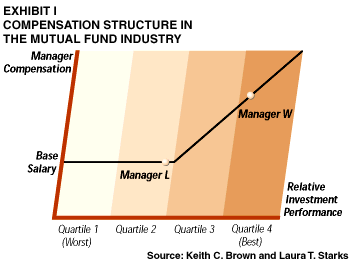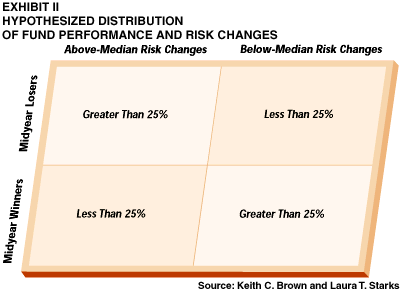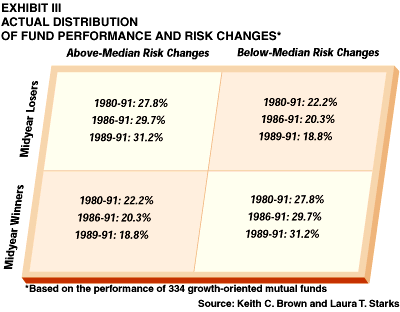Compensation Structures in the Mutual Fund Industry
If asked to name their 10 favorite sports heroes or movie stars, most people would have little trouble complying. However, if asked to list their 10 favorite professional money managers, the results would be far different. For those who could muster even a single name, the list might go no deeper than Peter Lynch (who is retired) and Warren Buffett. In short, the men and women working in the money management profession are virtually invisible.
Considering the amount of money at stake, this anonymity is quite surprising. A recent study by Goldman, Sachs & Company reported that by 1995, investment management companies controlled more than $6 trillion in mutual funds, pension plans, endowments and foundations.
Perhaps more disturbing is how little attention investors have paid to how money managers get compensated and whether these compensation schemes provide managers with the incentive to act in the investors' best interests.
Our research has concluded that certain money managers, due to the generally accepted method of compensation in the mutual fund industry, are likely to increase their portfolio's risk level in an effort to improve their chances of receiving higher bonuses. The altering of the risk level, one of a fund's most fundamental investment characteristics, might bolster a money manager's short-term goals, but it is almost certainly at odds with the long-term motivations of investors.
Previous research in the mutual fund industry has reached three important conclusions:
![]() When selecting a fund, the primary attraction for investors is past investment performance, with the more successful funds able to attract the majority of new assets.
When selecting a fund, the primary attraction for investors is past investment performance, with the more successful funds able to attract the majority of new assets.
![]() The rapid growth in the fund industry as a whole created a surprising result: funds that have been "winners" in the past see their assets under management grow while assets in "loser" funds do not shrink, but rather stay the same.
The rapid growth in the fund industry as a whole created a surprising result: funds that have been "winners" in the past see their assets under management grow while assets in "loser" funds do not shrink, but rather stay the same.
![]() Finally, most funds receive as a management fee some percentage of those assets under management, typically about 25-hundredths to 60-hundredths of 1 percent.
Finally, most funds receive as a management fee some percentage of those assets under management, typically about 25-hundredths to 60-hundredths of 1 percent.
Building on these findings, our own research has shown that compensation in the mutual fund industry -- both to the company as a whole and to the individual manager -- can be viewed as a tournament in which the top performers receive the largest amount of remuneration. Like participants in a tennis or golf tournament, mutual fund managers are paid, in part, based on how their performance compares with that of a set of peers, i.e., managers at similar funds.
What matters in any tournament, of course, is not a participant's absolute performance but his or her relative standing at the end of the contest. Indeed, a very typical compensation scheme in this business pays the manager a base salary as well as a bonus that depends on where his or her performance ranks in the relevant comparison "universe" at the end of the compensation period. This bonus might be structured as follows: 100 percent of base salary if the manager finishes in the top quartile of the universe, 50 percent if in the next highest quartile and zero percent if below the median.
Exhibit I illustrates the essential nature of this compensation arrangement. In particular, notice that the manager's compensation cannot be worth less than the base salary but will increase proportionally with the manager's relative performance after some point. In this example, the manager starts receiving a bonus when he or she generates a return for the fund's investors that is in the upper half of the peer group. Conversely, the manager whose performance falls below the median receives no bonus, whether finishing just below the mid-point or dead last in the rankings.

Indeed, the crucial factor is that any manager whose performance is below the median near the end of a compensation period (e.g., Manager L in the exhibit) has little to lose by increasing portfolio risk in an attempt to finish in the top half.
PROPER MOTIVATION OR ADVERSE INCENTIVES?
On the surface, there is little to suggest that establishing a positive linkage between the investor's return and a manager's reward is improper. After all, if every manager received the same fixed salary no matter what their investment performance, why would anyone ever strive to produce better than average returns? It is the anticipation of a superior reward that provides managers with the incentive to take the risks necessary to excel for their clients.
Nevertheless, our research has shown where conflict might arise in this type of compensation structure. Specifically, we have found that toward the end of a compensation tournament, managers most likely to finish below the median tend to increase their portfolio's risk level in an effort to improve their overall standing. As we noted, this altering of a crucial investment characteristic may be in the manager's short-term interest, but inevitably it conflicts with the long-term goals of investors.
To understand better why such risk manipulation occurs, consider this example: Suppose there are two investment managers competing against each other and that at the end of the current compensation tournament -- which by tradition coincides with the calendar year -- one will be declared a winner and the other a loser. Both managers will then be compensated according to their final status, with only the winning manager receiving a year-end bonus.
Midway through the tournament, Manager L finds that her performance is lagging behind that of Manager W; the two managers can be labeled interim loser and winner, respectively.
In this scenario, it is clear that Manager L has a strong incentive to increase the risk of her portfolio. If she is successful in increasing her return performance beyond that of Manager W, she will receive additional compensation. If not, her pay will remain what it is currently projected to be anyway. (Of course, if things were to get totally out of hand, and the increased risk produced terrible losses, Manager L might well face termination.)
On the other hand, Manager W might actually reduce portfolio risk in an effort to preserve his lead by "locking in" his present return level.
To document this behavior, we analyzed the performance of 334 growth-oriented mutual funds during the 12-year period from 1980 through 1991. Taking each year in this sample as a separate tournament, we considered two different aspects of a fund's performance: the fund's cumulative return between January and July, and the ratio of the fund's risk level (as measured by the standard deviation of returns) after the midyear point compared with its first-half risk level.
Each fund was then placed into the appropriate cell in a simple 2 x 2 grid according to whether it was a midyear winner or loser (i.e., cumulative return above or below the median) and whether its subsequent risk change was above or below the median for all funds.
As shown in Exhibit II, our hypothesis suggests that midyear losers should be more likely to increase risk while midyear winners are more likely to decrease risk (or increase risk by a far smaller amount).

We divided the study into three periods: the entire 12-year period, the most recent 6-year subperiod and the most recent 3-year subperiod. While Exhibit III shows the presence of the anticipated risk-altering behavior over the entire 12-year time frame, it was clearly much stronger in the last few years.

This means that the effects of the adverse incentives built into the compensation arrangement in the mutual fund industry are becoming increasingly more pronounced. Not surprisingly, this trend is consistent with the business and financial media's increased focus on relative fund performance, a change in emphasis that began in the mid-1980's.
Perhaps the most important implication of our research is the possibility that the current tournament structure in the mutual fund industry truly does provide adverse economic incentives to fund managers. By focusing so much attention on relative return performance, the industry unknowingly may be encouraging managers to alter fund objectives from a long-term to a short-term perspective.
Thus, within the current compensation environment, it appears that managers with the poorest midyear performance tend to act in a manner consistent with their own best interest and not necessarily in the best interest of the investors. Further, increased competition in the fund industry and the more widespread dissemination of information about relative fund performance appear to have intensified this trend. ![]()


